From Denmark With Love – A Mini System for 2021
‘In the House’ Review by David Neice
List Prices (MSRP)
Dali Spektor 1 speakers $399 CAD
Tangent Ampster BT II $349 CAD
Tangent CD II $349 CAD
Tangent Tuner II $349 CAD
Verdict: Are you young and just getting into hi-fi? Do you need a second system for the office, your bedroom, cottage, or wherever? Are you downsizing to a smaller house or condo? This review might be an answer to your prayers. The DALI Spektor 1 speakers are tiny but mighty, and the Tangent separate components are mini-system sized, and modularized so you can buy what you need – and stack them. The whole thing will fit into a large shoebox and the sound is strikingly good. The price is right too. For under $1100 (before tax) you get terrific speakers, an amplifier that includes Bluetooth streaming capability, and a quality CD player. An optional FM Tuner is also available. Or, say you already have a source (or just want streaming), the amp and speakers would be under $750. In today’s rather expensive audio market, never has so much been offered for so little money.
Remember…..the Mini-system?
In the mid 1990s an array of mini-systems were still available in the shops. I lived in the UK for a couple of years during that period and if you went into a Dixon’s (something like Best Buy here), they were everywhere to be seen.
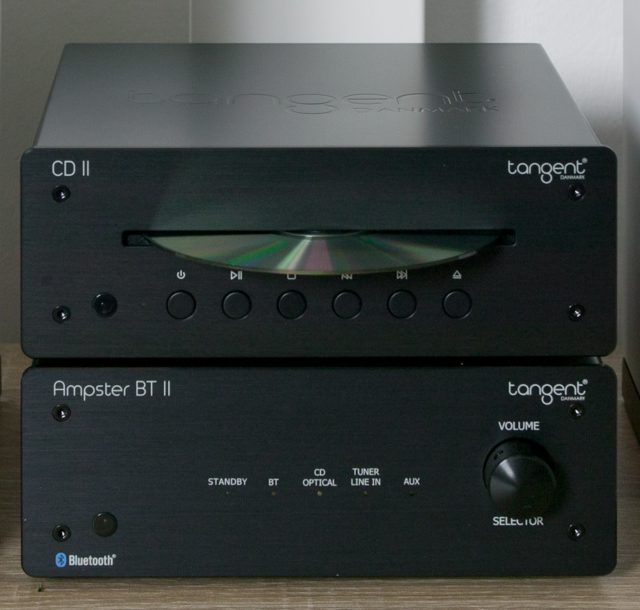 A lot of them were just a step up from a boom box with all plastic cases and faux seams that made them look like they were separates. But some units by TEAC, Sony and Panasonic were the real deal, with separate small stacked components and real wood (well, maybe MDF and vinyl) speakers. The speakers were often defeated by the speaker cable supplied. It was maybe two strands of skinny 24 gauge wire, but the general idea was still intact. Then these mini-systems pretty much disappeared at least in North America.
A lot of them were just a step up from a boom box with all plastic cases and faux seams that made them look like they were separates. But some units by TEAC, Sony and Panasonic were the real deal, with separate small stacked components and real wood (well, maybe MDF and vinyl) speakers. The speakers were often defeated by the speaker cable supplied. It was maybe two strands of skinny 24 gauge wire, but the general idea was still intact. Then these mini-systems pretty much disappeared at least in North America.
Since then, compact systems have not found much favour here. Big systems rule the roost. However, in the UK and in Europe there has always been keen competition for small and compact systems that sound good. This may well be due to the size of their listening rooms (and bedrooms) which are often quite compact as compared to ours.
One of the big pluses of a mini-system is the price. A lot of sound can be had for not much money. I like that approach because it beckons to young people that audio in their life can be enlarged by getting off the earbuds and listening instead to speakers.
This winter Noam Bronstein started trading in ideas for affordable mini-systems for the current age, this one being an “entry level” package. It’s small, modular/expandable, and it sounds terrific. He then asked if I would review it. Since I love reviewing speakers, let’s start there.
Enter the DALI Spektor 1 Speakers
Wow. April Fool’s Day is a long way off, but the way this Danish speaker company DALI has crammed a large speaker into their very inexpensive Spektor 1s is enough to fool me. These things are absolutely dinky and yet they still sing loud and clear.
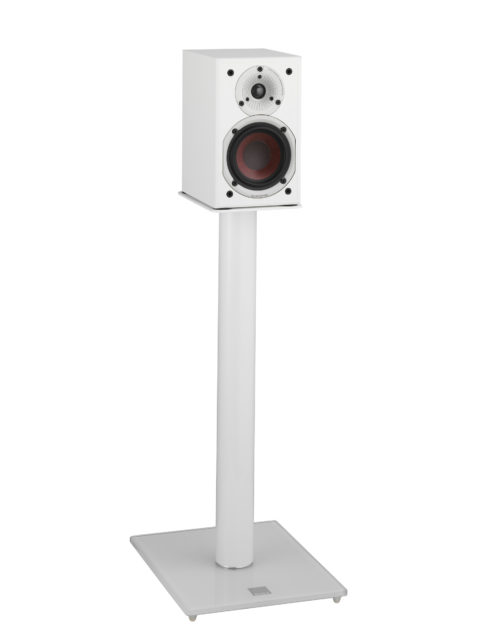
I keep looking at them while shaking my head and saying ‘it cannot be’ as their dimensions are 5.5 X 7 X 9 inches – almost invisible. The first time I ever heard a Rogers LS3/5a, it was sitting on top of a Spendor BC3 (about a 50 liter cabinet). The sales guy doing the demo asked me which speaker was playing, and it was hard to know. I have the Spektor 1s sitting on top of my DALI Oberon 5s and it is hard to know which is playing. I am sitting two rooms away right now while I write this and they still sound pretty amazing.
Unlike here in Canada, really small speakers are available in Europe from dozens of manufacturers, domestic and imported. If you drop in to any ‘Richer Sounds’ store in the UK you will find whole walls of them. Even their floor standers are compact by our standards.
The DALI Spektor 1s are quite tiny, but offer up that signature big DALI sound field. Of course, they aren’t perfect. There is a mild mid-bass/mid-range forwardness, but all this does is act to highlight vocals and supply valuable upper harmonics to the bass lines. The tweeter can be a bit whiffy at times, but not so much that you focus on it to the distraction of the rest. Overall, the balance is terrific and the image is very very good; wide and highly precise even if not terribly deep.
Some Comparisons
So what do you get for a measly $400 bucks. Quite a lot it seems. The DALI Spektor 1s are a huge advance over, say, the NHT SuperZeros. We’ve been waiting quite a while for this cheap miracle of sound to arrive. All RS Minimus 7 owners/fans should get out there and listen to the Spektor 1s. Same for adherents to the Wharfedale Diamonds, Paradigm Atoms and PSB Alphas. These little crackers are the real deal.
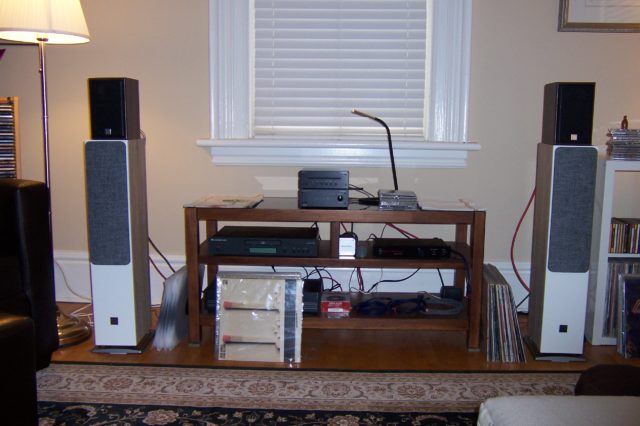 The Spektor 1s are rear ported and include rubber pads for stand mounting, as well as small brackets for wall mounting. I’m not recommending they be wall-mounted, but people may choose that option. I thought I would give them their best shot initially, and so I placed them seven feet apart and about 18 inches from the back wall. Sitting on top of the Oberon 5s put them about 30 inches off the floor. Ideally I think they need to be on 28 inch stands but I didn’t have a pair of those sitting around.
The Spektor 1s are rear ported and include rubber pads for stand mounting, as well as small brackets for wall mounting. I’m not recommending they be wall-mounted, but people may choose that option. I thought I would give them their best shot initially, and so I placed them seven feet apart and about 18 inches from the back wall. Sitting on top of the Oberon 5s put them about 30 inches off the floor. Ideally I think they need to be on 28 inch stands but I didn’t have a pair of those sitting around.
I also used a low-powered tube amp when I first set them up, my Unison Research ‘Simply Italy’, and it could drive them to ear splitting levels. From the first notes that issued forth I knew they were going to be amazing and I was frankly flabbergasted at how much good sound was issuing from these tiny boxes.
Whether the source was CD or vinyl, the Spektor 1s did an admirable job of reproducing the original. I say this while also having some useful points of comparison. I use NHT SuperZeros in my secondary system and the DALIs are far superior. In addition, I owned a pair of Spendor S3/5 R2s for quite a while and I can say without equivocation that I would far prefer listening to the DALIs.
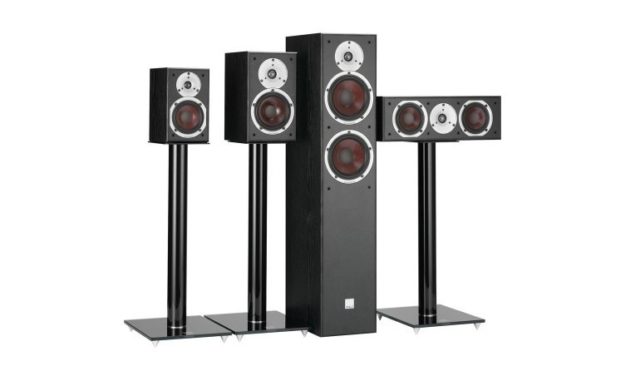
There are, of course, other very good compact speakers around, and certainly some quite highly regarded candidates by Proac and Harbeth that would challenge the little Spektors. But on a price versus performance basis there is really no contest. Invoking those brands in my comparisons should let the reader know that I take these baby DALIs seriously. You even get colour choices.
Desert Island Speakers?
In fact, a couple of weeks of listening to them had me convinced that these little DALIs were my ‘desert island speakers’. What’s that you say?? Suppose I had to pack fast, and was limited to a few audio items that could go in a suitcase with me to a desert island (with electricity) for several years. Would I be happy with these as my companions? Yes, I am quite sure they would fill the duties required.
In summary, these are tiny but brilliant loudspeakers, and if I were reviewing them outside this package, I would award the Spektor 1s their own ‘Wall of Sound Gold Star’. Well done, DALI!
Stereo on the Cheap with a Small Footprint
Denmark evidently offers us more than just speakers. Consider the Tangent line of mini components.
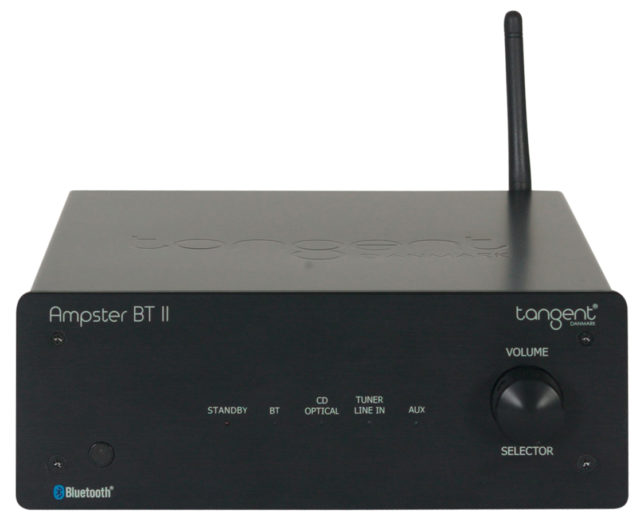 The Tangent Ampster BT II is an evolved design that has already garnered numerous good reviews. The amp is very small, but well built, with a solid metal case and quality fittings on the back. Being so compact, and inexpensive, it’s perhaps not surprising to find that the Ampster is a Class D design. And it sounds quite good, it’s yet another example of how far budget Class D sound has come over the last 10 years or so.
The Tangent Ampster BT II is an evolved design that has already garnered numerous good reviews. The amp is very small, but well built, with a solid metal case and quality fittings on the back. Being so compact, and inexpensive, it’s perhaps not surprising to find that the Ampster is a Class D design. And it sounds quite good, it’s yet another example of how far budget Class D sound has come over the last 10 years or so.
The amp is rated at 25 Watts into 8 ohms and 50 Watts into 4 ohms, and it all sounds hefty enough if the speakers are well matched. The specs don’t indicate harmonic distortion or how flat the frequency response measures. No matter, the design seems competent, so the target audience are getting what they pay for – a small, versatile, fun and affordable amp.
The front panel has LED indicators for each input, and a dual purpose knob can either select the inputs or control the volume. The back reveals more goodies. Besides the Bluetooth antenna, there are two pairs of beautiful five way speaker output sockets mounted in the center. These are accompanied by 1) a single RCA input (labeled ‘Tuner’) as well as 2) an optical input, 3) a 3.5 mm auxiliary input, 4) an IR socket, 5) a mono subwoofer output, and 6) a USB charging port. Enough inputs to accommodate a variety of options. Those needing a headphone output will have to look elsewhere.
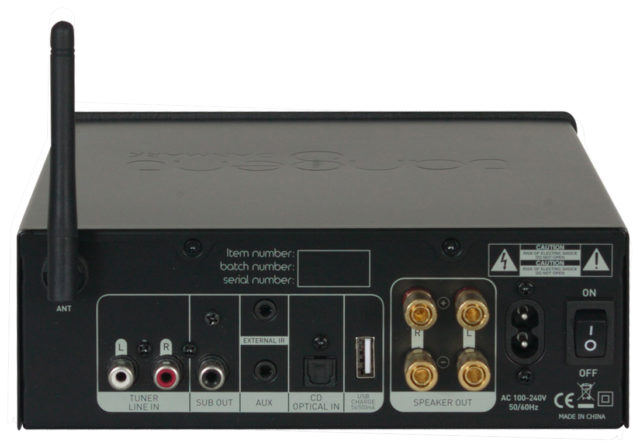 The included inputs are specifically designed to mesh with the other Tangent mini-components such as the CD II player/transport (discussed below) as well as the optional FM Tuner, which would be connected via the RCA jacks. If you add in the Bluetooth streaming capability, this affords a pretty complete range of input options. The subwoofer output is a benefit too, as many powered subwoofers that were designed for computer systems now languish on shelves and in basements, and these are available cheaply.
The included inputs are specifically designed to mesh with the other Tangent mini-components such as the CD II player/transport (discussed below) as well as the optional FM Tuner, which would be connected via the RCA jacks. If you add in the Bluetooth streaming capability, this affords a pretty complete range of input options. The subwoofer output is a benefit too, as many powered subwoofers that were designed for computer systems now languish on shelves and in basements, and these are available cheaply.
Tangent’s infrared remote control is small but has everything – including tone controls, not found on the amp itself (I didn’t use them). The remote works well, and can control the CD II as well. Also included is an IR remote extension cable that plugs in at the back. A nice touch. Using this extender can make the unit almost location free – users can consider hiding the amplifier in a cabinet, such as one might do if using it around a television setup. Class D operation means that almost no heat is generated by the amp, so, with the extender, it can be stowed out of sight while still remaining operational.
The CD II Player
The CD II player is also a fine candidate for comment, whether through the optical cable or the RCA outs. It is a dead simple player. Instead of a drawer or tray it has a slot feed that grabs the CD and pulls it into the player and then registers it and begins play. I generally prefer slot loading devices to trays.
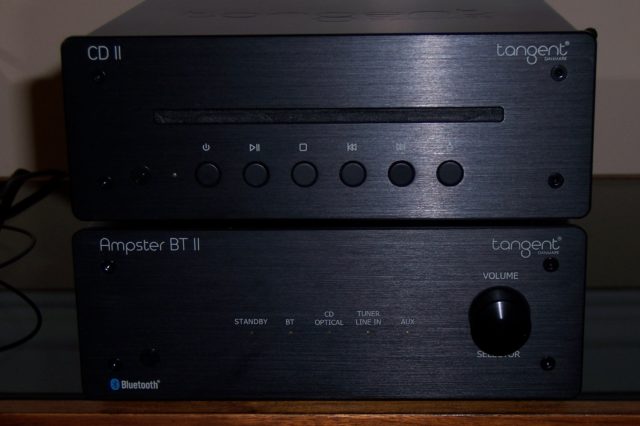 The unified remote also controls the CD II player (yes, if you buy the Ampster and CD II, you’ll have two identical remotes) and all the standard buttons are there, including the eject button which pushes the CD out for removal. Fortunately the compact disc will not emerge until the eject button is pressed. This is unlike automobile CD players that often eject the CD after it has played and maybe not at an opportune moment.
The unified remote also controls the CD II player (yes, if you buy the Ampster and CD II, you’ll have two identical remotes) and all the standard buttons are there, including the eject button which pushes the CD out for removal. Fortunately the compact disc will not emerge until the eject button is pressed. This is unlike automobile CD players that often eject the CD after it has played and maybe not at an opportune moment.
The CD II player is minimalist. For instance it doesn’t have a digital readout or even any LED indicators to let you know what it’s doing. Less stuff in the circuit that could detract from the sound, one might argue. Round the back of the CD player there is the optical out connector (an optical cable is included), as well as the analog outputs, which allow you to connect the CD II as a player using regular RCA interconnects – either into the Ampster’s Tuner input, or into any other analog amplifier, powered speakers, etc.
Overall operation of the CD II player was smooth and consistent, and through both the optical output and the RCA outs the sound was a joy to hear. You really cannot ask for much more at this price level.
Bluetooth
The Bluetooth implementation will handle the aptX codec, which I have on my Samsung phone and is now pretty common. So I tried the complete rig on Bluetooth with Spotify and it works well, although for the audiophile in me it’s still not quite real hi-fidelity, and I stuck mainly with my CDs. I should add though, the fidelity produced with lossy files very much depends on the quality of the initial recording. Some of the tracks I played on BT were older soul and R & B recordings and were not that well made. Modern tracks, however, were quite respectable. (Spotify Hi-Fi was announced around the time of preparing this review. -Ed.)
Listening Time
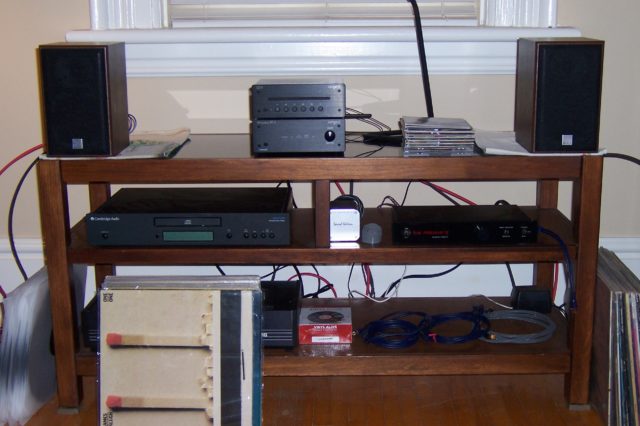 I strapped everything together and set the units up on an equipment table (see photo). I placed the speakers flat on the equipment stand about 4.5 feet apart and at knee high level. From a purist’s viewpoint this is not ideal, but it is a mini-system after all and many potential owners will set it up this way – for example in a student’s dormitory, or in a bedroom system or an office. Some compromises are often going to be necessary.
I strapped everything together and set the units up on an equipment table (see photo). I placed the speakers flat on the equipment stand about 4.5 feet apart and at knee high level. From a purist’s viewpoint this is not ideal, but it is a mini-system after all and many potential owners will set it up this way – for example in a student’s dormitory, or in a bedroom system or an office. Some compromises are often going to be necessary.
I did not find the speakers suffered unusually with this less than preferred placement. Of course, nothing prevents the owner from setting things up in the more traditional/ideal audio way. If that is possible then I suggest 28 inch stands and with the speakers about seven feet apart.
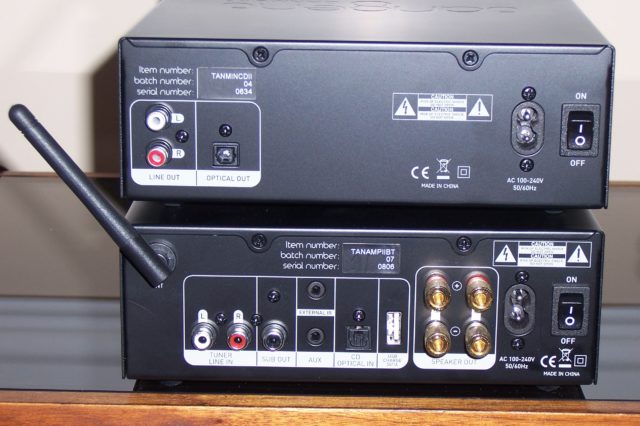
I listened to CDs for several days and found the combination to be quite pleasant and musical, which I cannot say had been my experience with past mini-systems. Generally, except for the most expensive mini-systems of the 1990’s, the average contender was tinny, shrill and offered far less than the normal expectations that people might have about hi-fidelity. In contrast, the DALI/Tangent combo was able to bring real musical joy into my living room. Long sessions proved unfatiguing and held many sonic surprises. One is not accustomed to small systems teaching you about the fine points of recorded music, but I can emphatically say that the DALI/Tangent combo brought new delights to the array of music that I plowed through.
Finally, as a test of flexibility, I dismantled the system and set it up again in my TV room where I ran the optical out from the TV into the Ampster. The results were as expected. The DALI/Tangent combo did a fine job as a 2.0 TV set up, and I could see lots of people integrating it into a modest media room installation, and adding a small powered subwoofer too.
Flexible Options
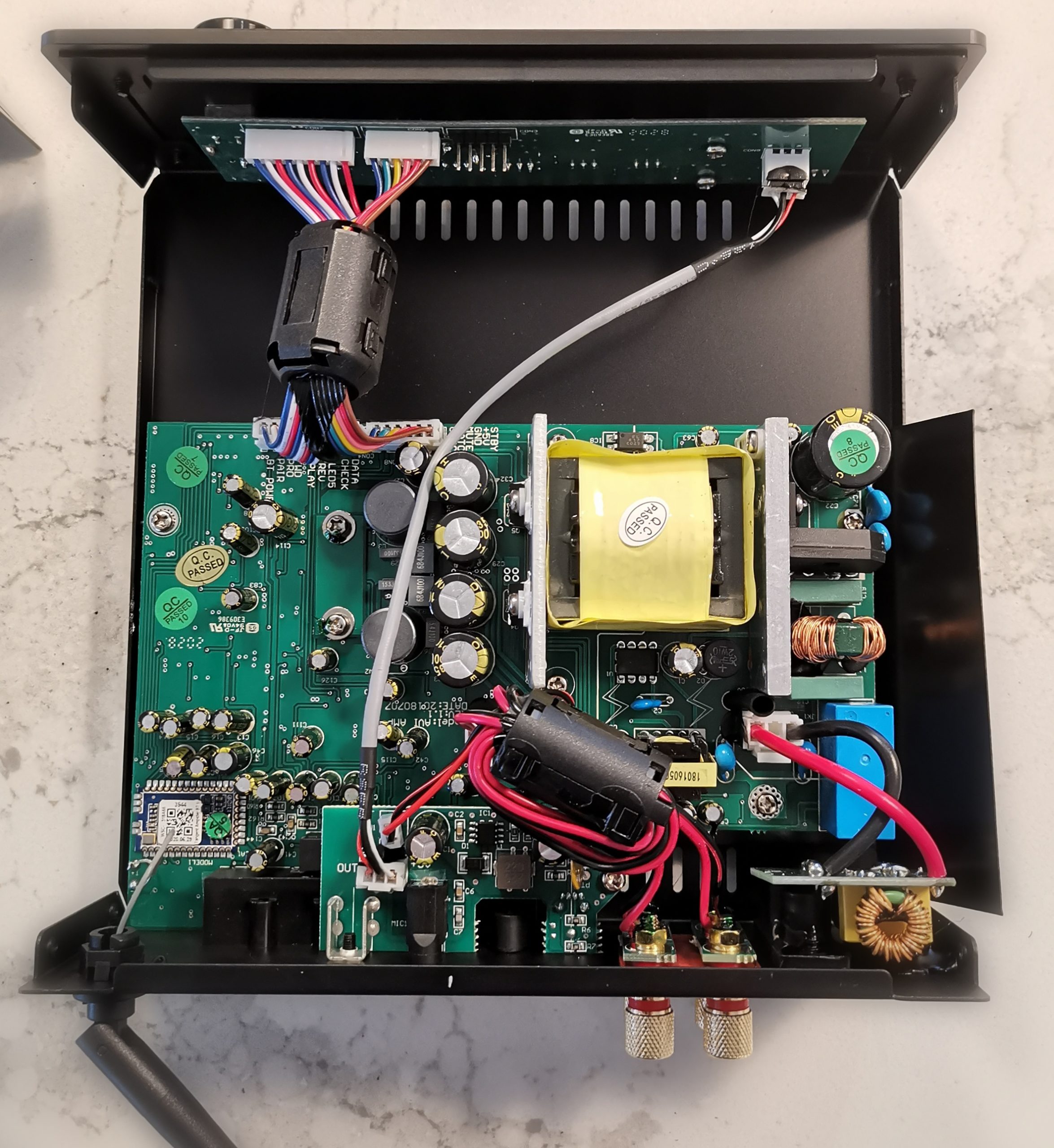
Let’s see what you can assemble for not much dosh. The Ampster and a pair of DALI Spektor 1s takes you to $750 Canadian (MSRP). You get Bluetooth aptX streaming capability and room to connect other sources. You can even plug your phone or tablet into the AUX connection at the back, and charge the device on the USB port at the same time. These features can be found in other systems, but all this looks like a bargain for the sort of sound that issues forth.
Are you really thrifty? Then go search the thrift shops or Kijiji and find a used CD/DVD player with optical out. It will set you back another $25 to $35 at most. Connect it to the Ampster, either with the analog input, or using the internal DAC on the amp. Trust me, it is a very listenable DAC and supports up to 24/96 resolution.
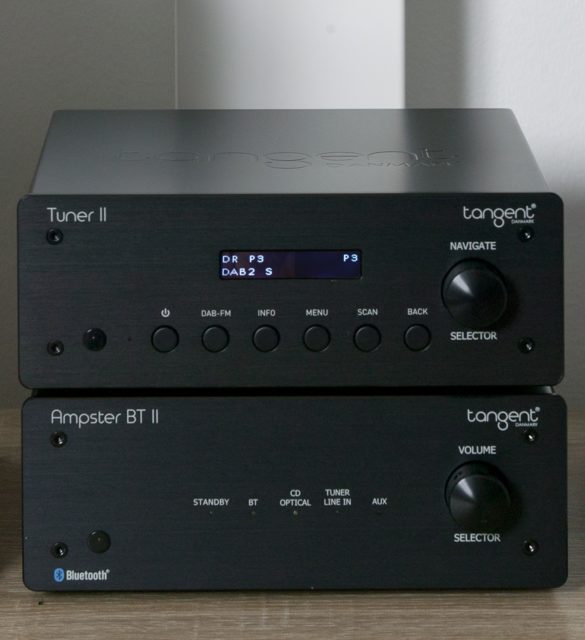
Stepping up a notch, you can add the matching Tangent CD II player, and we’re up to $1100. This will expand the range of media options and will bump the sound quality up a not-insignificant step. For today’s purposes, this is a complete system. But suppose you favour the radio over listening to CDs. Then for the same amount of money you can purchase the Tuner II unit in place of the CD player and enjoy the best of analog radio (and yes, you get another remote control). I did not have an opportunity to audition the FM tuner, but it appears similarly well thought out.
Finally, for under $1450 you could purchase the complete stack of Tangent components as well as the DALI speakers with, in effect, no significant limitations on media sources.
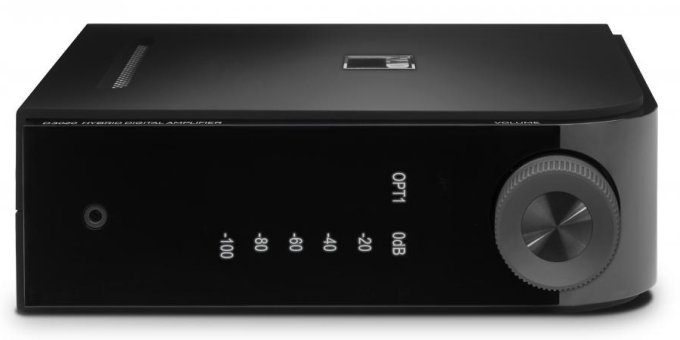
Other options are available to buyers, too. Those who need a phono stage and headphone jack can look at NAD’s capable and compact D3020V2 ($499) instead of the Ampster. You could choose the highly-regarded DALI Spektor 2 speakers, a larger model than the Spektor 1s, but quite comparable, at $100 more. I briefly auditioned the Spektor 2s, and their sound field is quite similar but they are large enough to really need stands, whereas the Spektor 1s can be simply dropped onto any flat surface such as a bookshelf or a computer table, or a convenient bench. Go up another $100 and the DALI Oberon 1s would be a great choice – similar in size to the Spektor 1s and offering more resolution and insight. From this survey of ‘entry-level high end’ mini-systems, the Spektor 1 seems to be my preferred choice.
Conclusion
Compact systems have not been wildly popular in North America, but times are changing. With more people now in downtown condos and other small living spaces (mom and dad’s basement) the need for compact systems may be rising. Indeed, some people are now downsizing their large systems and are quite happy to ditch the complexity. A good example of a simple decluttering strategy can be found in a DALI Oberon 5 based system we wrote about recently, here.
A mini-system, even one this good, isn’t for everyone. But if your space is limited and and you don’t need party room sound levels, there’s no reason not to benefit from the small footprint it offers up. I highly recommended checking out the latest audio mini offerings.
Basic Technical Specifications
DALI Spektor 1: Two way, Bass reflex, Rear ported, 59 to 26,000 Hz frequency range, 83 db sensitivity, 6 ohm impedence, cross-over frequency is 2100 Hz, Size is 237 X 140 X 195 mm, Weight 2.6 Kg., Recommended amplifier power 40-100 watts.
Tangent Ampster BT II: Class D, 25 Watts at 8 ohms and 50 Watts at 4 ohms
https://www.dali-speakers.com/products/spektor/#products-list
https://tangent-audio.com/products/9-electronics/
Disclosure: Wall of Sound is owned by Noam Bronstein, who also owns the retail store Stereo Untypical, a dealer for DALI/NAD and Tangent.

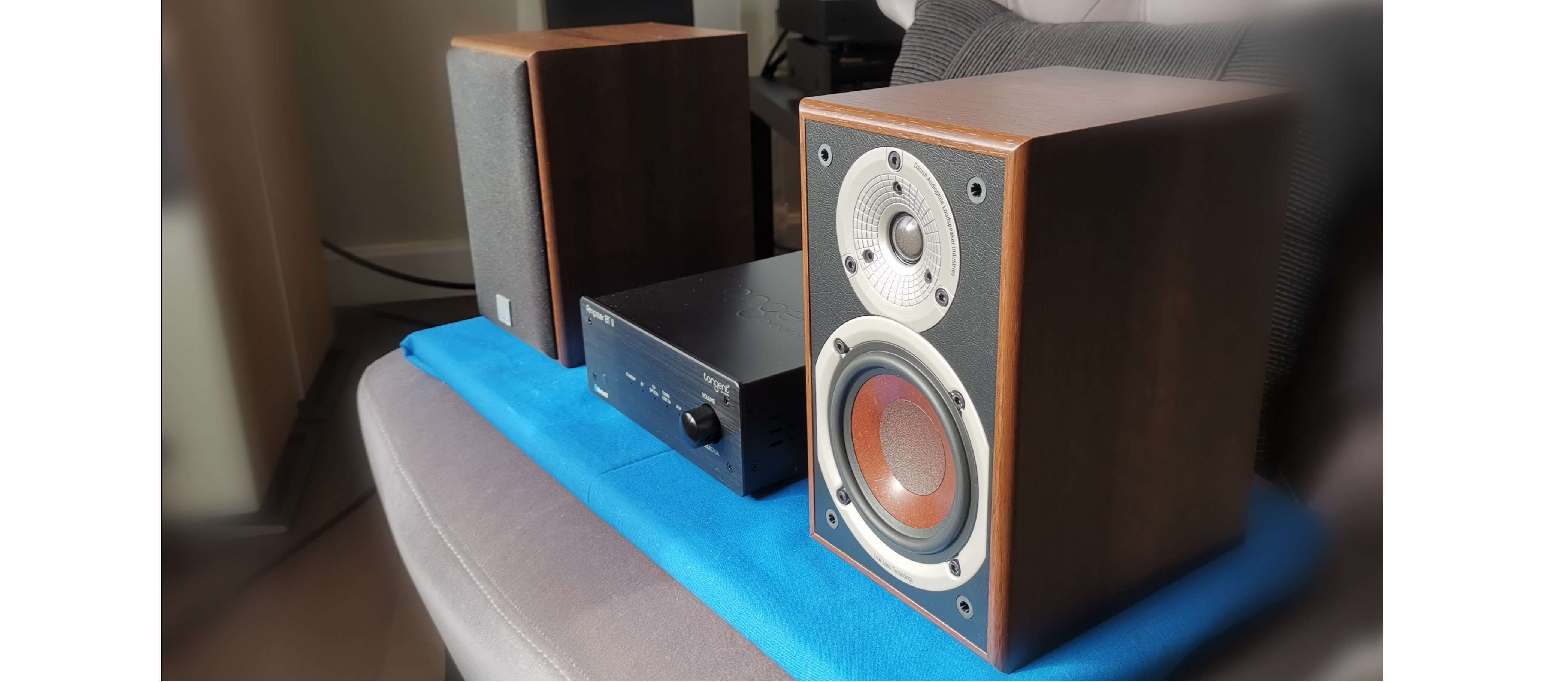
Another well written review David, thank you for your insight! I have a pair of the Dali Oberon 5’s and I am very happy with them (my wife is too) because they have a small footprint and a large soundstage!
Ahh, those small sound systems. Always had a penchant for them. Still have a nice Teac 300 series system in the bedroom paired with a set of Totem dreamcatchers. Its small enough to keep on a dresser, but nice enough to look at. Very classy looking setup.
As people tend to downsize their homes, smaller quality sound systems will be more popular, especially with the advent of inexpensive class D amplification.
How is it you claim a low power tube amp can make the Dali’s “ear splitting levels “
They are rated at 83 Db ….how is this so?
The old butt dyno.
HI Nigel,
e
Good question. Hyperbole took over I think. What I shsoudl have said was this: ‘The Dalis are very easy to drive and in a small room were able to achieve significant output even when paired with a low output Class A tube amp (EL34). I was surprised by the ease with which they would play quite loud even when rated at 83 or 84 db efficiency.’
Also I listen at relatively low levels. That’s better I think. Cheers, David Neice
I have just got a Tangent Cd2 player. But how on earth do I play tracks 6-10??
It would be great if you would let me know.
Many thanks from Inverness, Scotland
Tim Honnor
Hi Tim,
I’m not really sure what you mean. It’s true the CD II is very spartan as far as features, and has no display. But it should play all tracks on a disc?
Noam